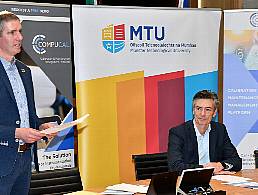As the deadline for the first round of CAO applications draws to a close, we have a suggestion for applicants.
This can be a stressful few months for Leaving Cert students. On top of having to sit one of the most high-pressure exams of your life, you’re also expected to decide what you want to do with the rest of that life.
Now, with the CAO application deadline looming, the pressure is mounting. And the opportunities are truly boundless.
But to deny that life – and your career – after college can be a challenge in spite of those boundless opportunities would be naïve. Sometimes, no matter how hard you work, finding that first job, in an area that you want to be in, is not as simple as walking in off the street and getting hired.
For those concerned about landing a job upon graduation, a STEM career could be the answer.
The STEM sector has been riding a seemingly endless wave of growth. As humankind continues to reach for the stars, the work undertaken in tech, research and design is expanding exponentially. This has led to immense talent gaps across the sector, and they need to be filled.
The Higher Education 2015/2016 report produced by the Higher Education Authority (HEA) had some encouraging figures.
The turning tide
Out of 43,117 new full-time undergraduate students in that academic year, 11pc were studying natural sciences, maths and statistics; 11pc were studying engineering, manufacturing and construction; and 7pc were studying information and communication technologies (ICT).
For the 156,717 students then enrolled in full-time undergraduate education, those percentages held steady.
These figures represented a 42pc increase in the number of undergrads studying natural sciences, mathematics, construction and ICT.
Even at this rate, it may not be enough to stem the skills and talent gaps that persist across the life sciences, research and tech sectors, so you shouldn’t look on increasing trends as a reason to avoid those areas.
The gaps are far wider than just over 11,000 graduates per year can fill. And, when you consider the consistent growth across each of those sectors, it’s likely that the gaps will get wider faster than we can bridge them.
Room for more
Cybersecurity experts estimate that, by 2020, there will be a staggering 1.5m vacant roles in the sector. Internet of things futurists foresee a connected future consisting of between 20m and 30m connected devices worldwide by 2020. Both of those areas will need a constant influx of talent to maintain restless innovation.
On the science and research side, we stand at the precipice of an exciting time for scientists. As Europe continues to invest in research of all stripes, opportunities to shape the future of this world are becoming more readily available.
Research can also take a range of forms, offering the chance to settle in a discipline that truly appeals to you, rather than being shoehorned into an aspect of science that holds no interest for you.
Researchers at DCU recently created a video series (above) to showcase the diversity of research being undertaken in Ireland at the moment. This is just a small fraction of what is possible with a background in science or engineering. According to that HEA report, 46pc of full-time post-graduate research falls under the STEM umbrella.
Arguably, a STEM career is without limits. As with most things, it is what you make it. But, with a STEM qualification, you might perhaps be flying the nest with a few more possibilities under your wing.
Looking for jobs in tech or science? Check out our Employer Profiles for information on companies hiring right now and sign up for our Career Republic e-zine for a weekly digest of sci-tech careers news and advice.
Chemical laboratory image: Mehendra_art/Shutterstock




